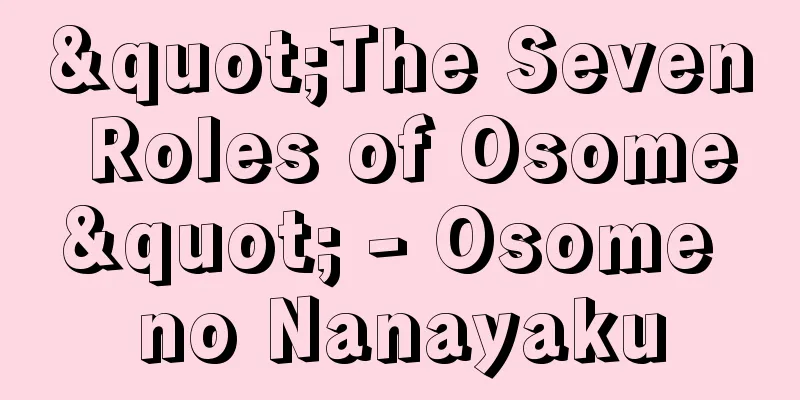Suwa faith

|
A nationwide faith that worships Suwa Taisha Shrine in Suwa City, Nagano Prefecture. The deity enshrined is said to be Takeminakata no Kami, but according to the chapter on the transfer of the country in the Kojiki, this deity was dissatisfied with the transfer of the country and fought with an envoy from Takamagahara, but was defeated. He then fled to Suwanoumi in Shinano Province and was given a fief there. In other words, it is an ancient shrine dating back to the Age of the Gods, and it is said that there are about 10,000 branch shrines enshrined throughout the country. This faith was once spread by wandering pilgrims called Suwa Jinin, and judging from their distribution, it originated from the faith of the Izumo clan that lived from the Hokuriku region to Shinano, but it has changed over the years. In ancient times, he was revered as a hunting god, but in the agricultural era, he was at the height of his power as a farming god, and in the samurai era, he was a war god. In the "Ryōjin Hisho" (Chronicles of the Imperial Family) compiled by Emperor Goshirakawa, he appears as "the war god east of the barrier, Kashima Katori Suwa no Miya," and was regarded as the guardian deity of samurai alongside the war gods of the Yamato Imperial Court. Later, he was called Japan's greatest war god, and during the Sengoku period, he was worshipped as the guardian deity of the Takeda and Tokugawa clans of Kai (Yamanashi Prefecture). Today, he is widely worshipped as a god of health and water resources. [Toshihiko Uda] [Reference] |Source: Shogakukan Encyclopedia Nipponica About Encyclopedia Nipponica Information | Legend |
|
長野県諏訪市にある諏訪大社を尊崇する全国的信仰。祭神は建御名方神(たけみなかたのかみ)とされるが、この神は『古事記』の国譲りの段によると、国譲りを不服として高天原(たかまがはら)の使者と闘争して敗れ、科野国(しなののくに)洲羽海(すわのうみ)に逃れて、その地に封ぜられたと伝えられる。すなわち、神代以来の古社であり、全国に勧請(かんじょう)された分社は約1万を数えるともいう。この信仰は、かつては諏訪神人(じにん)とよぶ遊行者(ゆぎょうしゃ)によって流布されたもので、その分布状態からみると、北陸から信濃(しなの)にかけて居住していた出雲(いずも)系族類による信仰に起源するが、時代によって変遷がある。大昔は狩猟神として尊敬されたが、農耕時代には農耕神として、また武家時代になると武神として全盛を極めた。後白河(ごしらかわ)法皇撰(せん)の『梁塵秘抄(りょうじんひしょう)』には「関より東の軍神(いくさがみ)、鹿島香取(かしまかとり)諏訪の宮」とみえ、大和(やまと)朝廷の軍神と並んで武士の守護神とされ、のちには日本第一大軍神とよばれ、戦国時代には甲斐(かい)(山梨県)の武田氏、徳川氏の守護神として信仰された。現在は、健康の神、水利の神として広く信仰されている。 [菟田俊彦] [参照項目] |出典 小学館 日本大百科全書(ニッポニカ)日本大百科全書(ニッポニカ)について 情報 | 凡例 |
Recommend
Lactobacillus
…For example, the genus Bifidobacterium is a memb...
Hobel
...Coal is extracted by moving along the face at ...
Elias, JS - Elias
…The paper became authoritative, but it became bo...
Atka mackerel (English spelling)
...A marine fish of the family Scorpaeniformes (i...
Gibier - jibie (English spelling) gibier French
Wild birds and animals captured by hunting and th...
Computation model - Keisan model (English notation) computation model
A mathematical model of the calculations performed...
Kawanishi [town] - Kawanishi
An old town in Nakauonuma District, southern Niiga...
Colbertism
...Based on his basic idea that the amount of cur...
Performance - Kougyou
Generally speaking, it refers to an event that is...
Tin hydroxide (tin hydroxide)
Tin hydroxides in the oxidation states II and IV a...
Taiheikimono - Taiheikimono
A type of puppet theater and kabuki. A general ter...
Dominant caste (English spelling)
… A village community is a basic local group form...
Tornio - Tornio (English spelling)
A town in northwestern Finland, on the border with...
Natchez (English spelling)
A city on the Mississippi River in the southwester...
Bacon, N. (English spelling)
…A peasant revolt that occurred in the Virginia c...









